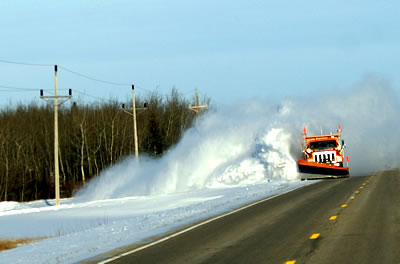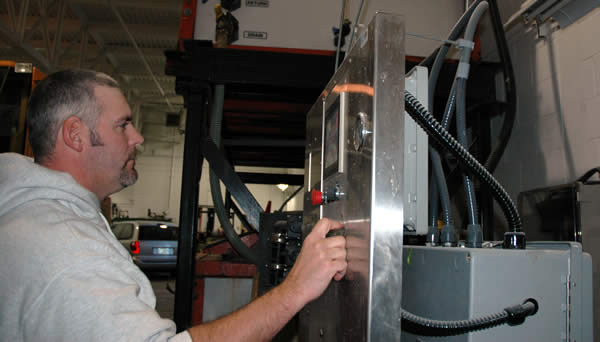By Craig Wilkins

A snowplow operator from the Bemidji District clears the shoulder along Hwy 59 after the Dec. 3 storm near Thief River Falls. Photo by Brian Bruckhoff |
The season’s first major snowstorm came in two parts—the first on a Saturday, the second timed just right to disrupt Monday’s evening rush hour.
The first stage delivered precipitation in all of its forms in some areas—snow, sleet and rain.
Precipitation fell in just that order in parts of southern Minnesota during the Dec. 1 storm, requiring maintenance crews to make constant adjustments in tactics.
Both District 6 and District 7 have high-capacity, automated systems that allow crews to mix just the right kind and proportion of liquid agents to meet changing temperature and other conditions.
Randy Glaser, a transportation generalist at Mankato, said his district started using a mixture known as liquid corn salt for anti-icing in advance of the Dec. 1 storm.
The substance is a mixture of corn syrup and brine. The corn syrup, Glaser said, helps the brine stick to road surfaces and works at lower temperatures than brine does. The mixture was used primarily on bridges in the Mankato and New Ulm areas.
The corn syrup leaves a residue that can reactivate when further precipitation falls, adding an extra measure of coverage, he said.
The mixing system enables operators to have the most suitable anti-icers as conditions change. He said, for example, that when rain threatens, operators will use a mix containing a higher ratio of brine or apply additional salt to prevent diluting the chemicals.
The district uses a 1,000 gallon capacity tanker to apply the liquid corn salt mix.
Dave Redig, maintenance superintendent at Rochester, said his area received the same winter sampler. He said the freeze-thaw-refreeze cycle kept crews busy taking care of icy spots days after the storms hit.
The Metro District is expanding its use of liquid corn salt as an anti-icer, said Norm Ashfeld, a district maintenance superintendent.
“We’ve used LCS for de-icing about five years; now we’re testing its effectiveness as anti-icer,” Ashfeld said. Metro, he added, also uses magnesium chloride for anti-icing when temperatures drop to near zero.
The Dec. 3 storm arrived along with the evening rush hour. There were problems, said Beverly Farraher, maintenance operations engineer, but she said the district received many messages commending its work under very trying circumstances.
Maintenance forces in northern Minnesota also used new innovations during the storms.
Bemidji/District 2 started use of its highly automated system that tracks snowplows and their operations and a program (the maintenance decision support system) that provides managers and operators with optimal choices for plowing, chemical use and other snow fighting tactics.
Jim Curran, assistant district engineer for operations at Crookston, said 35 of the district’s 67 plow route trucks are equipped with the systems.
Curran said initial results from the storms are promising.
“During the recent snow events, operators and supervisors used data such as road and weather condition reports to support their operations. Operators also received information such as chemical use recommendations right in their trucks.”
Supervisors used the tracking system (known as automatic vehicle location or AVL) to locate the units as needed for safety and dispatch purposes.
“There are details to work out as with any new technology,” Curran said, “but it sure looks like the system will be a nice tool for our operators, dispatchers and supervisors in the future.”

Mike Jacobson, a transportation generalist at Mankato, checks the operational status of the liquid chemical mixing system after the season’s first major storms. Photo by Craig Wilkins |
|



